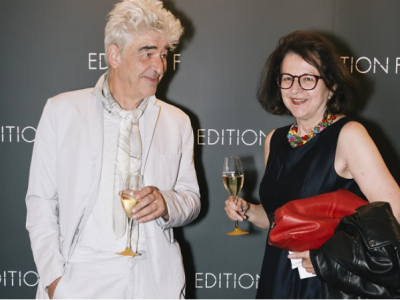
Monika Fleischmann and Wolfgang Strauss
Bio:
Monika Fleischmann (1950) and Wolfgang Strauss (1951) are pioneering German research artists, digital media scientists, and curators of new media art. They founded departments for interactive media art such as ART+COM in Berlin, the MARS (Media Arts and Research Studies) – Exploratory Media Lab and the eCulture Factory within the largest German research institutions such as GMD (Gesellschaft für Mathematik und Datenverarbeitung) and Fraunhofer Society. In 1992, the artist couple received the Golden Nica for Interactive Art of the Prix Ars Electronica for „Home of the Brain“ (1990), the first artistic Virtual Reality installation. They are recipients of the 2018 ACM SIGGRAPH Distinguished Artist Award for Lifetime Achievement in Digital Art. Both have taught as professors at universities and art academies. Their groundbreaking work on Virtual Reality, Visualization, Semantic Web and innovative Interface technology is exhibited worldwide, e.g. “Home of the Brain”, “Liquid Views”, “Energie-Passagen”, or archived on online platforms such as the scientific network and student competition “Digital Sparks” or the media art platform “netzspannung.org“. Their work is hosted at the ZKM | Center for Art and Media Karlsruhe. Since 2013, the artists have been working in Berlin on issues of the Denkraum.
Title: The Architecture of the thinking space – a room furnished with data.
Interactive media art creates new communication spaces. It is primarily concerned with processes and thought movements. Only in second place the aesthetics of the images becomes important. The images are not arbitrary, but sometimes random. Media art that works with new technologies has contributed to changing our society. Media artists, therefore, have a responsibility to accompany the digitalization of our global society critically. Fleischmann and Strauss do this with the concept of the “thinking space” of a “space furnished with data“. This is meant as an evocative environment or a space that is intended to stimulate learning and thinking. With their virtual reality installation “Home of the Brain” (1990) and later with the Mixed Reality installation “Murmuring Fields” (1997), they not only reflect on the new medium, but the discourse itself is exhibited here as a philosophical debate.
Thirty years ago, interactive installations of media art were soldered together by hand as blueprints of the media future. The senses were digitally redefined and the character of a “hyper-networked being” with intuitively sensitive yet disturbing interfaces was explored. Finally, with the invention of social media in the early 2000s, we have been connected to people and the consumer economy worldwide. This form of existence, which can be described as “living in mixed realities” (2001), has been realized faster than expected. Interactivity became hyperactivity. We live supra-individualized, connected to everything and at the same time isolated. This life form changes our language.
Today we drown in a mass of fake news and hate mails and we are about to lose our ability to navigate. Our democracy is being undermined. What counter-interfaces do we invent to critically reflect interaction in virtual space? Or is it enough to hold back and avoid the constant availability of “anti-social media”? In the joint discussion at the table (“Berlin, Cyber City”, 1989) we learn to think again “with the help of the imagination, but without giving up our own identity, to take up a position in the world that is not mine” (Hannah Arendt, 1960).
In their keynote address, the authors present fundamental works of their artistic research on the architecture of the “Denkraum” (thinking space).


